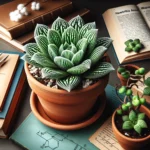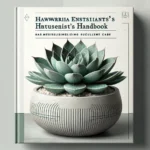Unveiling the Mystique of Haworthia Truncata
Welcome to a delightful exploration of Haworthia truncata, an enchanting succulent that exudes an air of mystery with its unusual form. This distinctive plant draws the eye and curiosity with its seemingly ‘cut-off’ tips, earning it the moniker of ‘truncated.’
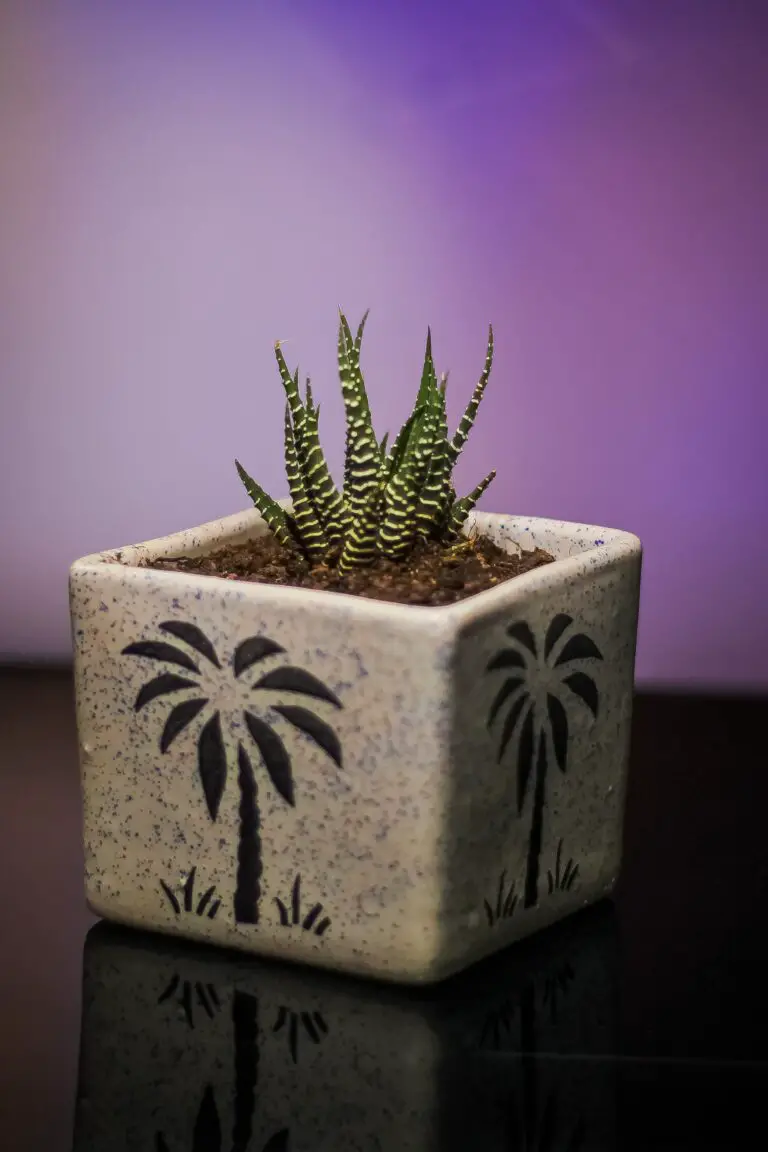
Residing natively in the arid realms of South Africa, Haworthia truncata presents itself as a natural piece of living artwork. Its striking, angular leaves and the remarkable mosaic they form illustrate why this plant is more than just flora—it’s a statement piece in any collection. Curious about its care? Take a look at this guide for some expert tips.
But it’s not just its geometric beauty that captivates enthusiasts worldwide. This succulent symbolizes resilience and adaptability, seamlessly thriving with minimal water and care. In an embrace of minimalism, one can find a reflection of life’s simplicity and the beauty that emerges from it. If you’re keen to discover more about succulent care, explore this detailed guide that demystifies the essentials for a thriving plant.
Indeed, Haworthia truncata not only enchants with its appearance but also teaches us about the incredible adaptations plants have made to survive in the most challenging environments. It’s an alluring reminder of nature’s ingenuity, tucked right within our homes as a small, thriving piece of the Earth’s diversity.
Optimal Conditions for a Thriving Haworthia Truncata
Imagine transforming your living space with a tiny, living sculpture that’s both exotic and easy to care for. Enter Haworthia truncata, a succulent that, with the right conditions, unfurls like a miniature green artwork on your windowsill. Let’s dig into the secrets of cultivating a healthy and happy Haworthia!
Shining the Right Light
Our little green friend adores bright light, but it’s a delicate dance between basking in the sun’s glory and scorching its leaves. Picture a shaded savannah where the sun flirts through the trees—that’s the sweet spot for your Haworthia. A north or east-facing window is its comfort zone, allowing it to glow without turning as red as a lobster!
Keeping the Temperature Just Right
Think of the ideal Haworthia temperature as a perpetual spring afternoon; not too hot, not too cold. We’re aiming for a Goldilocks range, between 65°F and 80°F (18°C to 27°C). Steer clear of the icy grip of winter drafts and the sizzle of direct heaters. Remember, if you’re feeling comfy, your Haworthia probably is too.

The Perfect Soil Mix
Close your eyes and imagine a soil that’s as light and fluffy as a gourmet cupcake. That’s what your Haworthia’s roots crave—a mix that’s one part potting soil, one part perlite, and one part wonder. It should drain quicker than a sink in a spy movie, leaving no soggy soil that could spell doom for those delicate rootlets.
Watering Woes and Wins
Here’s where many succulent enthusiasts trip up, turning their green dream into a waterlogged nightmare. Remember, it’s a desert darling we’re dealing with, not a water lily. Your watering can is not a fire hose! Gentle sips when the soil feels like a dry Sahara dune, not before, ensures your Haworthia thrives.
Intrigued to learn more? You’ll want to dive into a detailed Haworthia care guide on World of Succulents. It’s chock-full of wisdom to ensure your little green masterpiece remains the jewel of your plant collection.
Step-by-Step Guide to Propagating Your Haworthia Truncata
Let’s turn one into many! Propagating Haworthia truncata isn’t just rewarding, it’s a fun experiment in your own home. Envision each mature succulent as a proud parent ready to branch out and create a whole family of little green masterpieces. Whether you’re a seasoned green thumb or a budding plant enthusiast, this guide will give you a clear, simple pathway to propagating success.
Starting with Leaf Cuttings
Snipping the Perfect Leaf: It all starts with a clean cut. Grab a sterile pair of scissors or a knife, and choose a healthy, plump leaf from your plant. A swift cut near the stem ensures minimal stress to the mother plant and the beginning of a new journey for the leaf!
Rooting Up a Storm: Let your freshly severed leaf callus over for a couple of days in a warm, dry place. Once it’s got that nifty little scab, nestle it atop a well-draining soil mix and keep the faith. It might look like it’s just lazing around, but it’s working hard to sprout roots. With patience and sporadic watering, tiny roots will soon crave contact with the soil.
Play the Waiting Game: The magic of growth happens under the radar. Don’t rush, let nature take its course, and soon enough, you’ll spot mini Haworthia treasure troves popping up next to the mother leaf.
Offsetting Your Bets
Detachment with Care: Offsets, or ‘pups’, as I like to call them, are your cutest bet at multiplying your Haworthia collection. When you notice these little guys clinging to the base, gently wiggle them free with a clean tug or snip. Freedom is theirs, and the opportunity to grow into an individual masterpiece is imminent.
Another Rooting Rodeo: Similar to leaf cuttings, give these offshoots a brief respite to heal before introducing them to their new home soil. Coax them into root development with light, consistent moisture and watch as they establish themselves with gusto.
Seeds of Success
Crafting the Nursery: Seed propagation could just be the most exciting mystery novel in your gardening library. It starts with preparing a nursery tray with fine, sandy soil – a cozy cradle for your seeds to take root.
Sprinkle and Mist: Spread the seeds as if you’re seasoning a dish with salt – evenly and with care. A gentle misting assures them that the environment is just right, and placing the tray in a bright, warm spot is like setting the stage for a grand performance.
Now, let’s invite an audience to this propagation show! Visit our guide on succulent care for insights on caring for your growing plant family.
Patience Pays: Seedlings are in no rush. They make their grand entrance on their own terms, usually taking a few weeks to make their debut. Once they emerge, they’re like infants requiring attentive care, so plan on a nurturing environment with sufficient light and just the right touch of water.
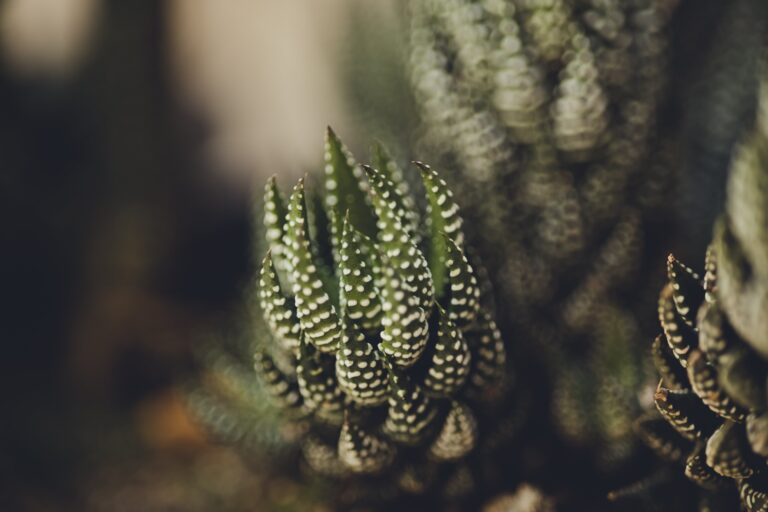
Unlock the wonder of Haworthia truncata’s miniature versions as you dabble in leaf cuttings, welcome the charm of offsets, or unfold the slow surprise of seeds. Propagation isn’t just about growing plants; it’s about the growth you’ll witness within yourself as a gardener—embracing both the responsibility and the delight that comes with nurturing new life.
Designing with Haworthia: Aesthetic Placement and Companion Plants
Bring a touch of geometric beauty to your living space with Haworthia truncata, the succulent that doubles as living art. But where do you start? Imagine your side table by the window, now picture a cluster of these little green gems, their sharp angles juxtaposed against the smooth curves of a ceramic planter. Your eyes are not just looking at another houseplant; they are witnessing modern design in its most organic form.
Think of your office desk, often cluttered, always busy. Now, add a pop of nature with a single Haworthia truncata, breaking the monotony of paperwork and devices. It’s not just about the greenery; it’s about introducing shapes and textures that invite serenity into your high-octane day. And when paired with the cascading trails of a String of Pearls plant or the bold rosettes of an Echeveria, you’re crafting a visual symphony that whispers of wild, untamed landscapes.
For those with a balcony or a miniature outdoor garden, integrating Haworthia truncata can transform your space. Take a wooden tabletop, add a cluster of these succulents in varying pot heights, and you’ve got an instant focal point that screams contemporary chic. Pair them with the larger, boldly textured leaves of Aloe vera to create a contrast that’s visually engaging and feels like a deliberate, thoughtful design choice.
Now, let’s get visual. Embed this video to see how Haworthia can magnify your home’s aesthetic:
Don’t forget to consider the care needs of your Haworthia’s companions. Create trios with other succulents and cacti that share similar light and water requirements. This allows for a cohesive care routine, making it easy to keep your little green artwork thriving. Stumped on where to begin? Our guide to indoor succulent care can provide a good starting point.
Whether your Haworthia makes a statement on its own or complements a group of succulent friends, the key is balance. Balance in size, color, texture, and growth habits—all factors that, when considered, elevate your home’s aesthetic from ordinary to extraordinary. Keep this in mind, and you’ll not only cultivate a thriving plant but also curate a living work of art.
Managing Pests and Diseases: Keeping Your Haworthia Healthy
Like any superhero with a weakness, the resilient Haworthia truncata is not immune to the nefarious dealings of pests and diseases. But fear not! With a bit of savvy and preemptive care, you can protect your succulent masterpiece from these villainous intruders.
Scouting the Enemy: Common Culprits
The first step to safeguarding your Haworthia truncata is knowing what you’re up against. Aphids, mealybugs, and spider mites might sound like creatures from a fantasy novel, but they’re all too real in the world of indoor gardening. They’re the sneak-thieves of the plant world, sipping away at the sap, leaving your plant weak and stressed. Picture this: a once vibrant, emerald haworthia now sticky with aphid residue or webbed over by spider mites—certainly not the aesthetic we’re going for!
Mealybugs, in particular, are the bane of many plant lovers. They’re like the Vikings of pests, pillaging your plant’s vigor with their waxy coats that shield them like armor. And let’s not start on root rot—a disease that sounds as grim as it is. It creeps up silently from overwatering or poor drainage, ready to lay siege to the roots of your green treasure.
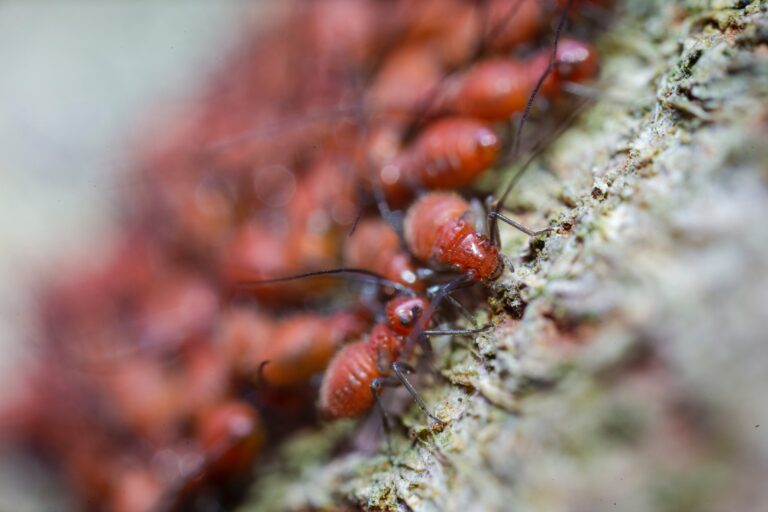
Fortifying Your Foliage: Prevention Tactics
Now that you’ve met the antagonist, it’s time to build your fortress. Start with a strong foundation—good soil and proper watering practices are your bedrock. Opt for a well-draining mix and never let water stagnate at the feet of your green warriors. Light is another ally—these plants love their sunbaths and will thrive when they can bask in the glory of the sunlight, properly armoring them against the dark arts of fungi and rot.
Consider this: you wouldn’t leave your front door unlocked in a neighborhood with a notorious thief. So why give pests an open invitation? Keep your Haworthia truncata clean and inspect it regularly. A sharp eye today could save you a world of trouble tomorrow. Quarantine new plants before introducing them to your collection, as they could be Trojan horses harboring unwanted guests.
Battling the Beast: Treatment Options
Should the enemy breach your defenses, it’s not yet time to raise the white flag. Rally your forces with insecticidal soaps or neem oil—a favorite among plant enthusiasts for its natural and effective pest-control properties. Spraying your Haworthia with a diluted solution can help banish the invaders. And if root rot has taken hold, act swiftly by trimming the affected areas and repotting into fresh soil, as you would amputate a knight’s wound to save the rest of the kingdom.
Real-life scenarios attest to the resilience of Haworthia truncata. Janet from Wisconsin once confided about her battle with mealybugs. With persistence and the strategic use of rubbing alcohol on a cotton swab, she turned the tides of war and reclaimed her plant’s health. The moral? Never give up, and tactical measures will triumph!
So there you have it. Your Haworthia truncata can indeed be your own little green artwork, unmarred by the blight of pests and disease, with just a bit of cunning and care. After all, isn’t a work of art worth protecting?
Key Maintenance Routines for Long-term Haworthia Health
Let’s dive into the nitty-gritty of Haworthia truncata care—your personal guide to keeping this succulent charmer looking its best. With the right touch, these chunky “Horse’s Teeth” can bite into the heart of any plant enthusiast. So, roll up your sleeves! It’s time to become the ultimate green thumb artist with our essential tips and tricks.
Seasonal Shifts: Tuning in to Your Plant’s Calendar
Imagine your Haworthia truncata singing on a brisk autumn day, begging you for a snug, bright spot to soak in the sun’s softer rays. As the seasons turn, adjust its position to ensure it gets 4-6 hours of indirect sunlight, no matter the winter chill or summer heat. This is your moment to play sun-chaser and keep those plump leaves glowing with health.
Repotting: The Key to Fresh Beginnings
Picture this: A cozy, spacious pot—a new home for your expanding green buddy. Every few years, this succulent craves a fresh abode with well-draining soil. Mid-spring whispers the perfect time for repotting. Get your hands dirty, and gently tease out the roots, reminding your Haworthia truncata that a little growth never hurts.
Seasonal Grooming: Keeping Those Teeth Sharp
Like any prized artwork, your Haworthia truncata needs an occasional dust-off to keep its edgy look. As leaves wither, gently snip them away—your concise strokes revive its vigor and maintain that just-out-of-the-gallery freshness. These little trimmings pave the way for a robust growth spurt, showcasing your plant’s relentless spirit.
Timing, tenderness, and a dose of adventurous spirit are all you need. Follow these key routines to ensure your Haworthia truncata stays healthy, happy, and ever-stunning. It’s not just about care; it’s about crafting a story with your little green artwork, one maintenance day at a time.
Haworthia Truncata’s Impact on Air Quality and Well-being
Welcome to the green corner of tranquility and health—where the humble Haworthia truncata lives as more than just a charming succulent. It’s a pint-sized powerhouse, punching above its weight in the realm of air purification and mental well-being. Let’s delve into the leafy science that turns your spaces into breaths of fresh air, literally and metaphorically!
Picture this: a little green sculpture adorning your work desk, casting intricate shadows as sunlight dances through its fleshy, window-like leaves. It’s not merely a delight to the eyes. Research suggests that the presence of plants like Haworthia truncata can play a role in scrubbing the air clean. They’re like miniature eco-warriors, battling unseen contaminants and volatile organic compounds, tirelessly working to improve the quality of the air you breathe.
But it’s not all about what they take out; it’s also about what they add in—serenity, focus, and a connection to nature, even in the smallest of urban jungles. The mental health benefits are palpable. A study into indoor plants indicated that interacting with houseplants, such as tenderly caring for your Haworthia, can reduce psychological and physiological stress. As you nurture it, it returns the favor, fostering a soothing environment that encourages calm and creativity.
Now, let’s take a virtual leap from the page to the screen, where you can witness these verdant marvels in action. Below is a video that embodies the essence of Haworthia truncata, bringing to light their allure and the practical benefits they offer. It’s a living example of nature’s subtlety in blending form with function—a true spectacle of the plant kingdom.
Think about it next time you feel that mid-afternoon slump creeping in or the persistent buzz of urban stress. A glance over at your compact green comrade might just be the breath of fresh air you need. With Haworthia truncata, it’s more than possible to cultivate your own little piece of calming nature. And who knows? It might just inspire a greener thumb and a clearer mind.
Frequently Asked Questions
Have you ever wondered if that adorable geometric succulent, the Haworthia truncata, has a personality of its own? Or maybe you’re puzzled about the quirks of its care? Well, plant lovers and green-thumbed newbies alike, get ready for some snappy answers to those burning questions!
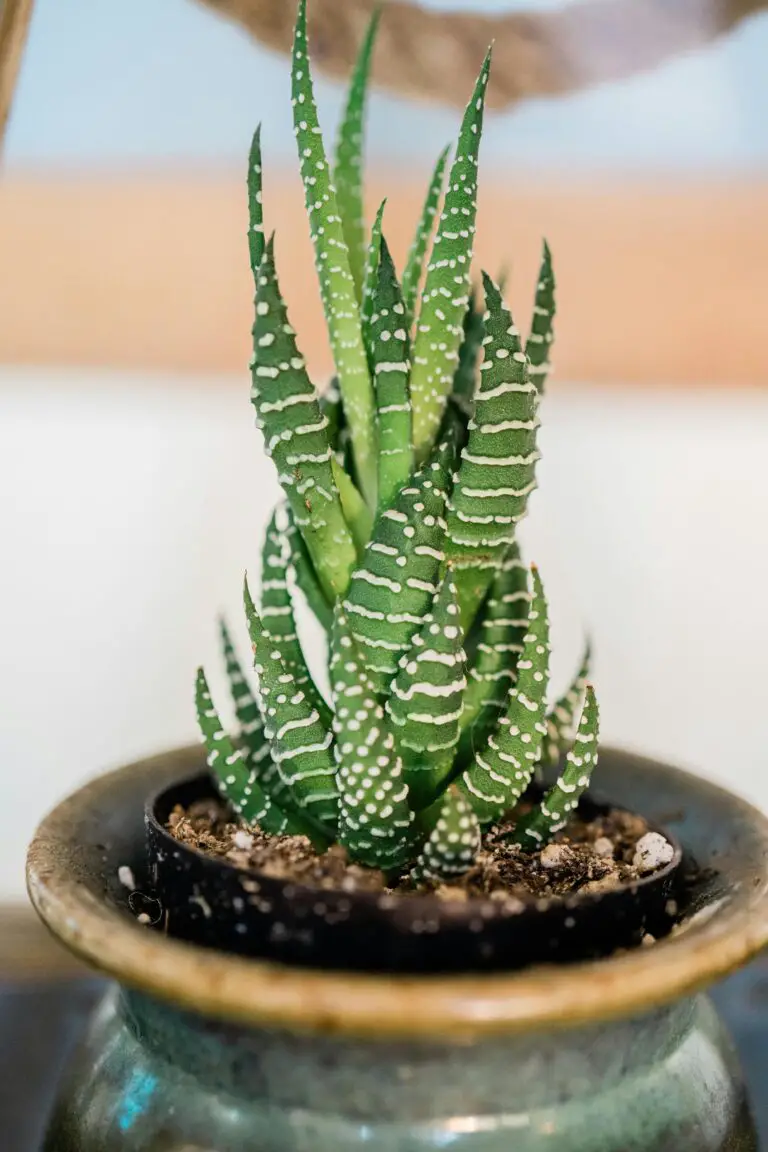
Is the Haworthia truncata Difficult to Grow?
Some say it’s as easy as pie, others think it’s a bit finicky, but let’s set the record straight. Think about Alice, who thought she had a black thumb after her basil wilted. Then she got a Haworthia truncata, and guess what? It’s thriving like it’s at a succulent spa! The key? Well-drained soil, indirect light, and remember, water is a treat, not a daily snack!
How Often Should I Be Watering This Plant?
Imagine watering your plant like you’re seasoning your food. You wouldn’t drown your pasta in salt, right? The same goes for your Haworthia truncata. Give it a sip just when the soil feels like a stale cookie — dry and crumbly. If you’re a forgetful Frank, this plant will forgive you, but a soggy Steve? It’s goodbye roots!
What’s the Best Soil Mix for Haworthia truncata?
Think of your plant’s soil like its home. Would it want a cramped studio, or a spacious loft? Get a soil mix that’s like a luxury condo with a balcony — airy, well-draining, with enough room for roots to stretch out. A bout of gritty sand, a dash of perlite, and a sprinkle of organic compost make for a perfect plant paradise.
Can I Propagate Haworthia truncata?
Are you the kind of person who likes to spread joy? Well, propagating this succulent is like sharing a piece of happiness. It’s a snap, literally! Take a healthy leaf, let the end callous over like a seasoned hiker’s heel, and rest it on the soil. With some patience and cheers of encouragement, you’ll have baby Haworthias popping up like excited gophers.
Any Pests or Diseases I Should Watch Out For?
Even the mighty Haworthia truncata must bow before the mighty mealybug or the sneaky spider mite. Keep an eagle eye out for these pests. Imagine them as little plant vampires, and you need to be the Van Helsing who saves the day. Keep them clean, and if the bugs show up, send them packing with a swift swipe of insecticidal soap!
Will Haworthia truncata Survive the Winter?
Imagine your Haworthia truncata as a bear hibernating in a cozy cave. It’s chilling, it’s conserving, and it’s not interested in a flurry of activity. Keep watering to a minimum, and ensure the temps don’t drop below frosty. If your house is on the cooler side, it might just doze off peacefully until the warmth of spring nudges it awake.

